Procter & Gamble Bundle
Who Really Controls Procter & Gamble?
Delving into the ownership of Procter & Gamble (P&G) unveils a fascinating story of corporate evolution and market dominance. Founded in 1837, this consumer goods giant has transformed from a soap and candle maker into a global powerhouse. Understanding Procter & Gamble SWOT Analysis is key to grasping its strategic direction and market influence.
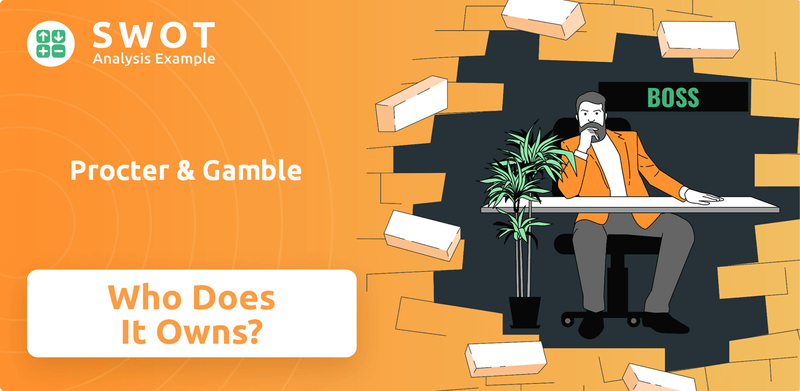
The question of "Who owns P&G?" goes beyond simple shareholders; it touches upon strategic decision-making, market trends, and the long-term vision of the Procter & Gamble company. With a market capitalization of approximately $400.11 billion as of July 2024, understanding the P&G ownership structure is crucial for investors and anyone interested in the company's future. This exploration will uncover the major P&G shareholders and the dynamics that shape this industry leader, including how to buy Procter & Gamble stock.
Who Founded Procter & Gamble?
The story of Procter & Gamble (P&G) began in 1837 in Cincinnati, Ohio. It was founded by William Procter and James Gamble, brothers-in-law who brought different skills to the table. Procter was a candlemaker, while Gamble was a soapmaker.
Their businesses merged thanks to the suggestion of their father-in-law, Alexander Norris. He saw the potential in combining their trades, as both used animal fat and lye, readily available from the local hog-butchering industry. This partnership laid the foundation for what would become a global consumer goods giant.
The initial ownership of the Procter & Gamble company was a direct reflection of this partnership. However, specific details about the initial equity splits are not publicly available. By 1859, the company had achieved impressive sales of $1 million and employed around 80 people, demonstrating early growth and success.
During the American Civil War, P&G secured contracts to supply soap and candles to the Union Army. This boosted profits and expanded the reach of their products across the nation. A significant step in employee relations came in 1887 when William Arnett Procter, William Procter's grandson, introduced a profit-sharing program for the workforce. This initiative aimed to provide employees with a stake in the company, which helped reduce the likelihood of strikes and foster a more engaged workforce. By 1890, the company had expanded its product line to include over 30 different soaps and incorporated to facilitate further expansion and capital acquisition.
- The founders, William Procter and James Gamble, established the company in 1837.
- The company secured contracts to supply soap and candles to the Union Army during the Civil War.
- A profit-sharing program was introduced in 1887 by William Arnett Procter.
- The company expanded its product line to over 30 soaps by 1890.
The early history of P&G ownership highlights the importance of strategic partnerships, adapting to market opportunities, and innovative employee relations. These factors contributed to the company's initial success and laid the groundwork for its future growth. For more insights, you can read this article about the history of Procter & Gamble.
Procter & Gamble SWOT Analysis
- Complete SWOT Breakdown
- Fully Customizable
- Editable in Excel & Word
- Professional Formatting
- Investor-Ready Format
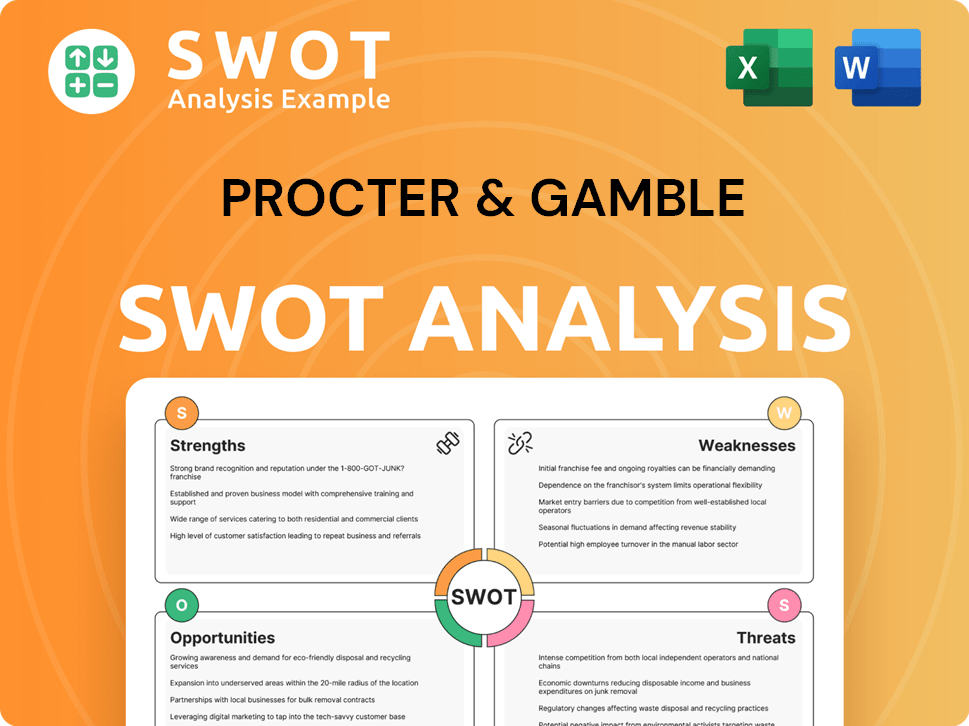
How Has Procter & Gamble’s Ownership Changed Over Time?
The evolution of Procter & Gamble from a family-run enterprise to a publicly traded entity marks a key shift in its ownership. This transition, culminating in its listing on the New York Stock Exchange (NYSE), significantly broadened its shareholder base. Now a component of major indices like the Dow Jones Industrial Average (DJIA), S&P 100, and S&P 500, the company's ownership structure is primarily influenced by institutional investors.
The shift to a publicly traded model allowed for increased capital and a broader investor base, fundamentally changing how Procter & Gamble operates and is governed. This transition was crucial for its growth, enabling it to make acquisitions and expand its product portfolio. The initial public offering (IPO) was a pivotal moment, transforming the company's financial landscape and opening it up to a wider range of investors, which continues to shape its strategic direction.
| Ownership Category | Percentage (March 2025) | Percentage (October 2024) |
|---|---|---|
| Institutional Investors | 69.33% | 69.14% |
| Mutual Funds | 53.29% | 52.88% |
| Individual Insiders | Smaller Percentage | Smaller Percentage |
The current P&G ownership structure is largely dominated by institutional investors and fund managers. As of March 2025, these institutional investors controlled approximately 69.33% of the company's shares, slightly up from 69.14% in October 2024. Mutual funds specifically increased their holdings, reflecting a growing confidence in the company's performance and strategic direction. Major institutional shareholders, such as Vanguard Group Inc., BlackRock, Inc., and State Street Corp, hold significant portions of the outstanding shares, influencing corporate strategy and governance through their voting power. The shift towards institutional ownership highlights the increasing professionalization of the company's investor base and its impact on strategic decisions. Individual insiders, including executives like Jon R. Moeller, also hold shares, aligning their interests with the company's performance.
The major shareholders of Procter & Gamble company play a crucial role in its direction. These large institutional investors have a significant impact on the company's strategy through their voting power and engagement with management.
- Vanguard Group Inc. held 230,022,172 shares as of March 31, 2025.
- BlackRock, Inc. held 178,152,589 shares as of March 31, 2025.
- State Street Corp held 100,185,368 shares as of March 31, 2025.
- Jon R. Moeller, the current Chairman, President, and CEO, held 635,984 common shares as of July 2024.
Procter & Gamble PESTLE Analysis
- Covers All 6 PESTLE Categories
- No Research Needed – Save Hours of Work
- Built by Experts, Trusted by Consultants
- Instant Download, Ready to Use
- 100% Editable, Fully Customizable
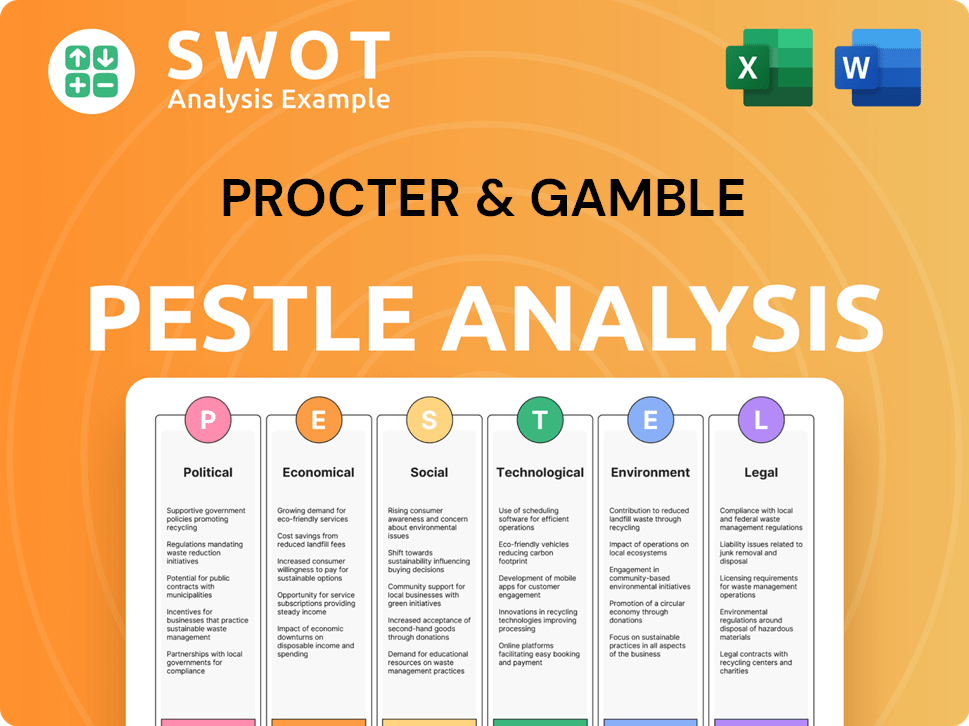
Who Sits on Procter & Gamble’s Board?
As of February 2025, the Board of Directors of Procter & Gamble (P&G) includes 14 members. These members are B. Marc Allen, Brett Biggs, Sheila Bonini, Amy L. Chang, Joseph Jimenez, Christopher Kempczinski, Debra L. Lee, Terry J. Lundgren, Christine McCarthy, Ashley McEvoy, Jon R. Moeller, Rob Portman, Raj Subramaniam, and Patricia A. Woertz. Jon R. Moeller holds the positions of Chairman, President, and CEO. Understanding the composition of the board is crucial for those looking into P&G ownership and who owns P&G.
The structure of the board reflects P&G's commitment to corporate governance, emphasizing diversity in gender, ethnicity, skills, and experience. The company operates with four Board Committees, all comprising independent directors. This structure is designed to ensure effective oversight and decision-making, which is important for P&G shareholders and the overall Procter & Gamble company.
| Board Member | Position | Date of Grant (June 2025) |
|---|---|---|
| Ashley McEvoy | Director | 185 shares |
| Joseph Jimenez | Director | 292 shares |
| Patricia A. Woertz | Director | 185 shares |
Shareholders of P&G common stock generally have a one-share-one-vote structure. Directors are elected by a majority vote, where the 'for' votes must exceed the 'against' votes, assuming a quorum is present. There are no indications of dual-class shares or special shares that would give specific entities outsized control. Recent filings show that board members receive equity grants, increasing their direct ownership. For example, in June 2025, Ashley McEvoy received 185 shares, increasing her direct ownership by 5%, and Joseph Jimenez received 292 shares, increasing his direct ownership by 0.88%. Patricia A. Woertz was also granted 185 shares in June 2025, increasing her direct ownership by 0.36%. Furthermore, P&G has provisions for proxy access for director nominees, allowing shareholders holding 3% of the common stock for at least three years to nominate directors. This mechanism encourages shareholder engagement and potential influence on board composition, which is key for anyone interested in how to invest in Procter & Gamble.
The Board of Directors at Procter & Gamble is composed of 14 members, with a focus on diversity and experience. This structure helps in making informed decisions for the company.
- The voting structure is one-share-one-vote.
- Directors are elected by a majority vote.
- Shareholders can nominate directors through proxy access.
- Learn more about the Growth Strategy of Procter & Gamble.
Procter & Gamble Business Model Canvas
- Complete 9-Block Business Model Canvas
- Effortlessly Communicate Your Business Strategy
- Investor-Ready BMC Format
- 100% Editable and Customizable
- Clear and Structured Layout
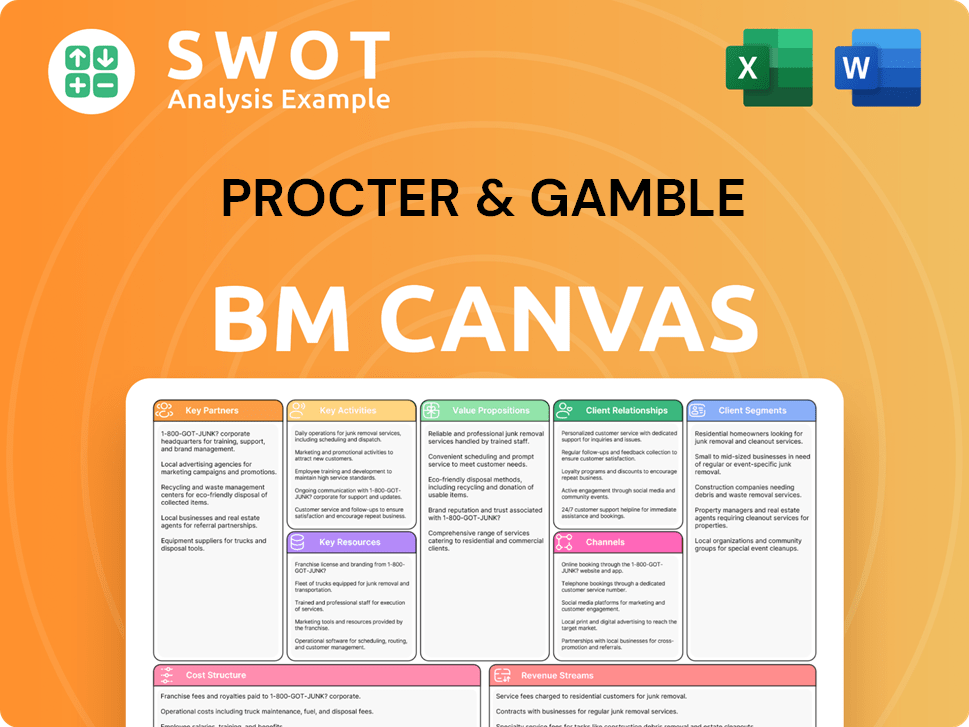
What Recent Changes Have Shaped Procter & Gamble’s Ownership Landscape?
Over the past few years, Procter & Gamble has consistently focused on returning value to its shareholders. In the first three quarters of fiscal year 2025, the company returned over $13 billion to shareholders through dividends and share repurchases. This commitment is further highlighted by its 69th consecutive annual dividend increase, announced in April 2025. Share buybacks in fiscal Q2 2025 amounted to $2.5 billion, demonstrating a continued dedication to enhancing shareholder value.
In terms of strategic adjustments,
P&G ownership
has been affected by the company's restructuring efforts. A two-year plan announced in June 2025 involves cutting approximately 7,000 non-manufacturing jobs, which is about 15% of its non-manufacturing workforce. This initiative aims to streamline operations, reduce complexity, and free up capital for high-potential areas. While not directly changing theP&G ownership
percentages, these moves can influence investor sentiment and stock performance.| Metric | Details | Data |
|---|---|---|
| Dividends and Share Repurchases (Fiscal Year 2025) | Amount Returned to Shareholders | Over $13 billion |
| Share Buybacks (Fiscal Q2 2025) | Amount | $2.5 billion |
| Restructuring Plan (June 2025) | Job Cuts | Approximately 7,000 non-manufacturing jobs |
Industry trends show increasing institutional ownership across the market, and
Procter & Gamble company
is no exception. Institutional investors increased their holdings in March 2025. Looking ahead to fiscal year 2025, the company anticipates flat all-in sales compared to fiscal 2024, with organic sales growth of around 2% and diluted EPS growth between 6% and 8%. The forecast for core EPS is between $6.72 and $6.82, representing 2% to 4% growth from the prior year.Procter & Gamble prioritizes returning value to
P&G shareholders
through dividends and share buybacks.The company is streamlining operations through restructuring, impacting its workforce.
Institutional investors are increasing their holdings, reflecting market trends.
P&G expects approximately flat sales with organic growth and EPS growth in fiscal 2025.
Procter & Gamble Porter's Five Forces Analysis
- Covers All 5 Competitive Forces in Detail
- Structured for Consultants, Students, and Founders
- 100% Editable in Microsoft Word & Excel
- Instant Digital Download – Use Immediately
- Compatible with Mac & PC – Fully Unlocked
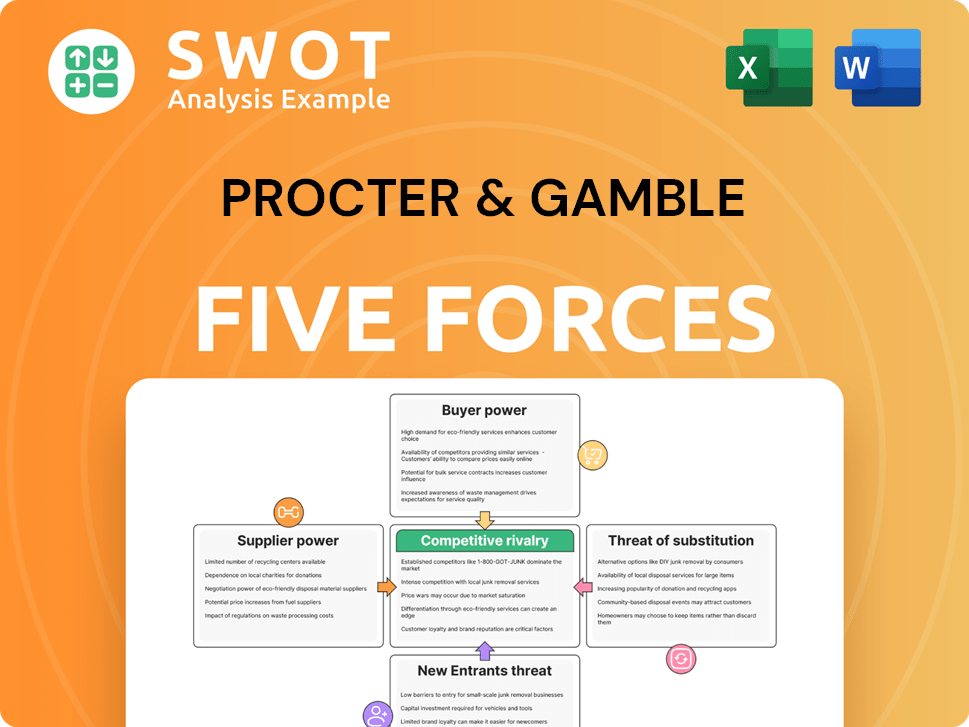
Related Blogs
- What are Mission Vision & Core Values of Procter & Gamble Company?
- What is Competitive Landscape of Procter & Gamble Company?
- What is Growth Strategy and Future Prospects of Procter & Gamble Company?
- How Does Procter & Gamble Company Work?
- What is Sales and Marketing Strategy of Procter & Gamble Company?
- What is Brief History of Procter & Gamble Company?
- What is Customer Demographics and Target Market of Procter & Gamble Company?
Disclaimer
All information, articles, and product details provided on this website are for general informational and educational purposes only. We do not claim any ownership over, nor do we intend to infringe upon, any trademarks, copyrights, logos, brand names, or other intellectual property mentioned or depicted on this site. Such intellectual property remains the property of its respective owners, and any references here are made solely for identification or informational purposes, without implying any affiliation, endorsement, or partnership.
We make no representations or warranties, express or implied, regarding the accuracy, completeness, or suitability of any content or products presented. Nothing on this website should be construed as legal, tax, investment, financial, medical, or other professional advice. In addition, no part of this site—including articles or product references—constitutes a solicitation, recommendation, endorsement, advertisement, or offer to buy or sell any securities, franchises, or other financial instruments, particularly in jurisdictions where such activity would be unlawful.
All content is of a general nature and may not address the specific circumstances of any individual or entity. It is not a substitute for professional advice or services. Any actions you take based on the information provided here are strictly at your own risk. You accept full responsibility for any decisions or outcomes arising from your use of this website and agree to release us from any liability in connection with your use of, or reliance upon, the content or products found herein.